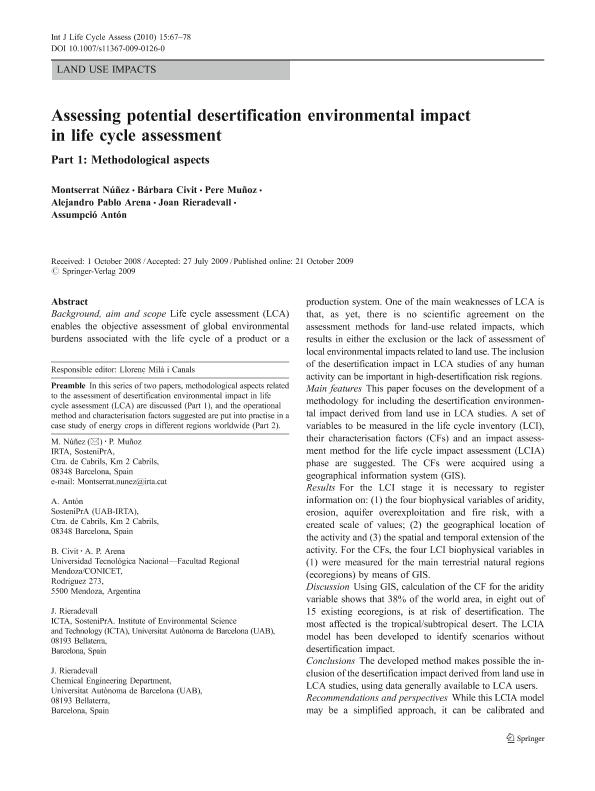Mostrar el registro sencillo del ítem
dc.contributor.author
Nuñez, Montserrat
dc.contributor.author
Civit, Bárbara María

dc.contributor.author
Muñoz, Pere
dc.contributor.author
Arena, Alejandro Pablo

dc.contributor.author
Rieradevall, Joan
dc.contributor.author
Antón, Assumpció
dc.date.available
2020-01-03T21:28:55Z
dc.date.issued
2010-01
dc.identifier.citation
Nuñez, Montserrat; Civit, Bárbara María; Muñoz, Pere; Arena, Alejandro Pablo; Rieradevall, Joan; et al.; Assessing potential desertification environmental impact in life cycle assessment: Part 1: Methodological aspects; Springer Heidelberg; International Journal Of Life Cycle Assessment; 15; 1; 1-2010; 67-78
dc.identifier.issn
0948-3349
dc.identifier.uri
http://hdl.handle.net/11336/93536
dc.description.abstract
Background, aim and scope: Life cycle assessment (LCA) enables the objective assessment of global environmental burdens associated with the life cycle of a product or a production system. One of the main weaknesses of LCA is that, as yet, there is no scientific agreement on the assessment methods for land-use related impacts, which results in either the exclusion or the lack of assessment of local environmental impacts related to land use. The inclusion of the desertification impact in LCA studies of any human activity can be important in high-desertification risk regions. Main features: This paper focuses on the development of a methodology for including the desertification environmental impact derived from land use in LCA studies. A set of variables to be measured in the life cycle inventory (LCI), their characterisation factors (CFs) and an impact assessment method for the life cycle impact assessment (LCIA) phase are suggested. The CFs were acquired using a geographical information system (GIS). Results: For the LCI stage it is necessary to register information on: (1) the four biophysical variables of aridity, erosion, aquifer overexploitation and fire risk, with a created scale of values; (2) the geographical location of the activity and (3) the spatial and temporal extension of the activity. For the CFs, the four LCI biophysical variables in (1) were measured for the main terrestrial natural regions (ecoregions) by means of GIS. Discussion: Using GIS, calculation of the CF for the aridity variable shows that 38% of the world area, in eight out of 15 existing ecoregions, is at risk of desertification. The most affected is the tropical/subtropical desert. The LCIA model has been developed to identify scenarios without desertification impact. Conclusions: The developed method makes possible the inclusion of the desertification impact derived from land use in LCA studies, using data generally available to LCA users. Recommendations and perspectives: While this LCIA model may be a simplified approach, it can be calibrated and improved for different case studies. The model proposed is suitable for assessing the desertification impact of any type of human activity and may be complemented with specific activity indicators, and although we have considered biophysical factors, the method can be extended to socio-economic vectors.
dc.format
application/pdf
dc.language.iso
eng
dc.publisher
Springer Heidelberg

dc.relation
Ver parte 1 en http://hdl.handle.net/11336/2667
dc.rights
info:eu-repo/semantics/openAccess
dc.rights.uri
https://creativecommons.org/licenses/by-nc-sa/2.5/ar/
dc.subject
ARIDITY INDEX
dc.subject
CHARACTERISATION FACTORS
dc.subject
DESERTIFICATION
dc.subject
GEOGRAPHICAL INFORMATION SYSTEM (GIS)
dc.subject
LAND USE IMPACTS
dc.subject
LIFE CYCLE ASSESSMENT (LCA)
dc.subject
LIFE CYCLE IMPACT ASSESSMENT (LCIA)
dc.subject
LIFE CYCLE INVENTORY (LCI)
dc.subject.classification
Otras Ciencias de la Tierra y relacionadas con el Medio Ambiente

dc.subject.classification
Ciencias de la Tierra y relacionadas con el Medio Ambiente

dc.subject.classification
CIENCIAS NATURALES Y EXACTAS

dc.title
Assessing potential desertification environmental impact in life cycle assessment: Part 1: Methodological aspects
dc.type
info:eu-repo/semantics/article
dc.type
info:ar-repo/semantics/artículo
dc.type
info:eu-repo/semantics/publishedVersion
dc.date.updated
2019-12-04T15:03:11Z
dc.journal.volume
15
dc.journal.number
1
dc.journal.pagination
67-78
dc.journal.pais
Alemania

dc.journal.ciudad
Heidelberg
dc.description.fil
Fil: Nuñez, Montserrat. IRTA, SosteniPrA,Barcelona.; España
dc.description.fil
Fil: Civit, Bárbara María. Consejo Nacional de Investigaciones Científicas y Técnicas. Centro Científico Tecnológico Conicet - Mendoza. Instituto de Ciencias Humanas, Sociales y Ambientales; Argentina. Universidad Tecnológica Nacional; Argentina
dc.description.fil
Fil: Muñoz, Pere. IRTA, SosteniPrA,Barcelona.; España
dc.description.fil
Fil: Arena, Alejandro Pablo. Consejo Nacional de Investigaciones Científicas y Técnicas. Centro Científico Tecnológico Conicet - Mendoza. Instituto de Ciencias Humanas, Sociales y Ambientales; Argentina. Universidad Tecnológica Nacional; Argentina
dc.description.fil
Fil: Rieradevall, Joan. ICTA, SosteniPrA. Institute of Environmental Science and Technology (ICTA)Universitat Autònoma de Barcelona (UAB)Barcelona.; España. Chemical Engineering DepartmentUniversitat Autònoma de Barcelona (UAB)Barcelona; España
dc.description.fil
Fil: Assumpció, Antón. SosteniPrA (UAB-IRTA)Barcelona.; España
dc.journal.title
International Journal Of Life Cycle Assessment

dc.relation.alternativeid
info:eu-repo/semantics/altIdentifier/url/https://link.springer.com/article/10.1007/s11367-009-0126-0
dc.relation.alternativeid
info:eu-repo/semantics/altIdentifier/doi/https://doi.org/10.1007/s11367-009-0126-0
Archivos asociados
